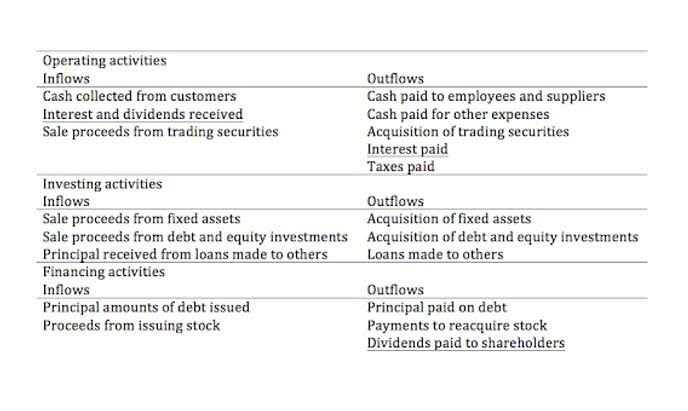Understanding Shareholders’ Equity SE and Its Calculation

You can see the shareholder’s equity line on the balance sheet completed in the example screenshot of a financial model that is shown below. The information used to determine the shareholders’ equity of company ABC Ltd. is presented above. The difference between return on equity (ROE) and return on assets (ROA) is tied to the capital structure, i.e. the mixture of debt and equity financing used to fund operations. One noteworthy consideration of the return on equity (ROE) metric is that the issuance of debt capital is not reflected since only equity is captured in the metric. Return on Equity (ROE) measures the net profits generated by a company based on each dollar of equity investment contributed by shareholders. The 40% equity ratio implies that shareholders contributed 40% of the capital used to fund day-to-day operations and capital expenditures, with creditors contributing the remaining 60%.

Treasury stock

Therefore, the stockholder’s equity of SDF Ltd as on March 31, 20XX stood at $800,000. Therefore, the stockholder’s equity of PRQ Ltd as on March 31, 20XX stood at $140,000. But an important distinction is that the decline in equity value occurs due to the “book value of equity”, rather than the market value.

How does total equity relate to the balance sheet?

Retained earnings, commonly referred to as accumulated profits, are the total revenue generated by the company less dividends paid to shareholders. When reviewing financial statements, information from shareholders equity is quite helpful. In https://www.bookstime.com/articles/operating-cycle liquidation situations, stock holders are paid last in line after debt holders. Ever wondered how much cash you as a shareholder would get if a firm was dissolved, all of its assets were sold, and all debts were settled?

How Is Equity Calculated?
Total Equity represents the value that would remain for shareholders if the company were to sell all its assets and pay off all its liabilities. In this case, the $700,000 in equity is the shareholder’s claim on the company’s assets after its debts have been settled. An alternative calculation of company equity is the value of share capital and retained earnings less the value of treasury shares. Company equity is an essential metric when determining the return being generated versus the total amount invested Certified Public Accountant by equity investors. For example, return on equity (ROE), which is the company’s net income divided by shareholders’ equity, measures how well a company’s management is using equity from investors to generate profit.
- The representation essentially equates all uses of capital or assets to all sources of capital where debt capital leads to liabilities and equity capital leads to shareholders’ equity.
- However, for privately held businesses, assets and liabilities should be relatively straightforward to calculate (or at least estimate), and therefore, stockholders’ equity can be found.
- Stock buybacks, also known as share repurchases, involve a company purchasing its own outstanding shares from the market.
- That, in turn, can help you to decide if a company is worth investing in, based on your goals and risk tolerance.
- To calculate a company’s equity, you essentially take its total assets and subtract its total liabilities.
- Calculating stockholders’ equity can give investors a better idea of what assets might be left (and paid out to shareholders) once all outstanding liabilities or debts are satisfied.
Low Total Equity
- Net income is the total revenue minus expenses and taxes that a company generates during a specific period.
- The math calculation is the same process you use to calculate your semester average in school or the scoring average of your favorite athlete.
- A good way to think of stockholders’ equity is the amount of money that stockholders would theoretically get if the company decided to close its doors, sell its assets, and pay all of its debts.
- Liabilities are obligations that the company owes to external parties, such as loans, accounts payable, and accrued expenses.
- Current and long-term assets are two main categories on a company’s balance sheet.
- In other words, if ABC Widgets liquidated all of its assets to pay off its debt, the shareholders would retain 75% of the company’s financial resources.
- As per the publicly released financial data, the following information is available.
It reflects the net worth of a business and is reported on the balance sheet under the equity section. A positive stockholders’ equity indicates that a company has more assets than liabilities, while a negative balance may signal financial distress or excessive debt. The shareholder equity ratio indicates how much of a company’s assets have been generated by issuing equity shares rather than by taking on debt. The lower the ratio result, the more debt a company has used to pay for its assets. It also shows how much shareholders might receive in the event that the company is forced into liquidation. Shareholder equity (SE), also known as shareholders’ equity, stockholders’ equity, or owners’ equity, represents the residual value of a company’s assets after subtracting all its liabilities.
- As such, it is a common financial metric which is used by most of the analysts to assess the financial health of a company.
- Current assets include cash and anything that can be converted to cash within a year, such as accounts receivable and inventory.
- Shareholders of a company are typically interested in the company’s shareholder’s equity, which is represented by their shares.
- Positive stockholder equity can indicate that a company is in good financial health, while negative equity may hint that the company is struggling or overextended with debt.
- There are no guarantees that working with an adviser will yield positive returns.
Why Shareholder Equity (SE) Matters
Equity is an important concept in finance that has different specific meanings depending on the context. For investors, the most common type of equity is “shareholders’ equity,” which is calculated by subtracting total liabilities from total assets. Many investors view companies with negative shareholder equity as risky or unsafe investments. But shareholder equity alone is not a definitive indicator of a company’s financial health. If used in conjunction with other tools and metrics, an investor can accurately analyze the health of an organization. Investors are wary of companies with negative shareholder equity since such companies are considered risky to invest in, and shareholders may not get a return on their investment if the condition persists.
- The shareholder equity ratio is expressed as a percentage and calculated by dividing total shareholders’ equity by the total assets of the company.
- While the shareholders’ equity balance can be found directly on the balance sheet, it can also be calculated by subtracting the company’s liabilities from its assets.
- The value available to common shareholders divided by the total number of outstanding shares in a corporation is known as book value per share (BVPS).
- SE is a number that stock investors and analysts look at when they’re evaluating a company’s overall financial health.
- In addition, a company’s assets and liabilities can change at any time because of unforeseen circumstances.
How to Calculate Average Shareholder Equity
The bottom line is that SE represents the remaining value of a company’s assets after subtracting all its liabilities. SE offers insight into a company’s financial position because it reflects its overall performance and indicates its long-term financial strength. While how to calculate total stockholders equity equity ownership offers potential for gains, it also comes with financial risks, limited control, and exposure to market forces that can negatively impact shareholders. BVE reflects the historical cost of a company’s assets minus depreciation and liabilities, providing a snapshot of the company’s accounting value. This metric is based on tangible assets and does not account for intangible factors like brand value, intellectual property, or future growth potential. Treasury stock does not carry voting rights, nor does it receive dividends, and it is not included in the calculation of earnings per share (EPS).